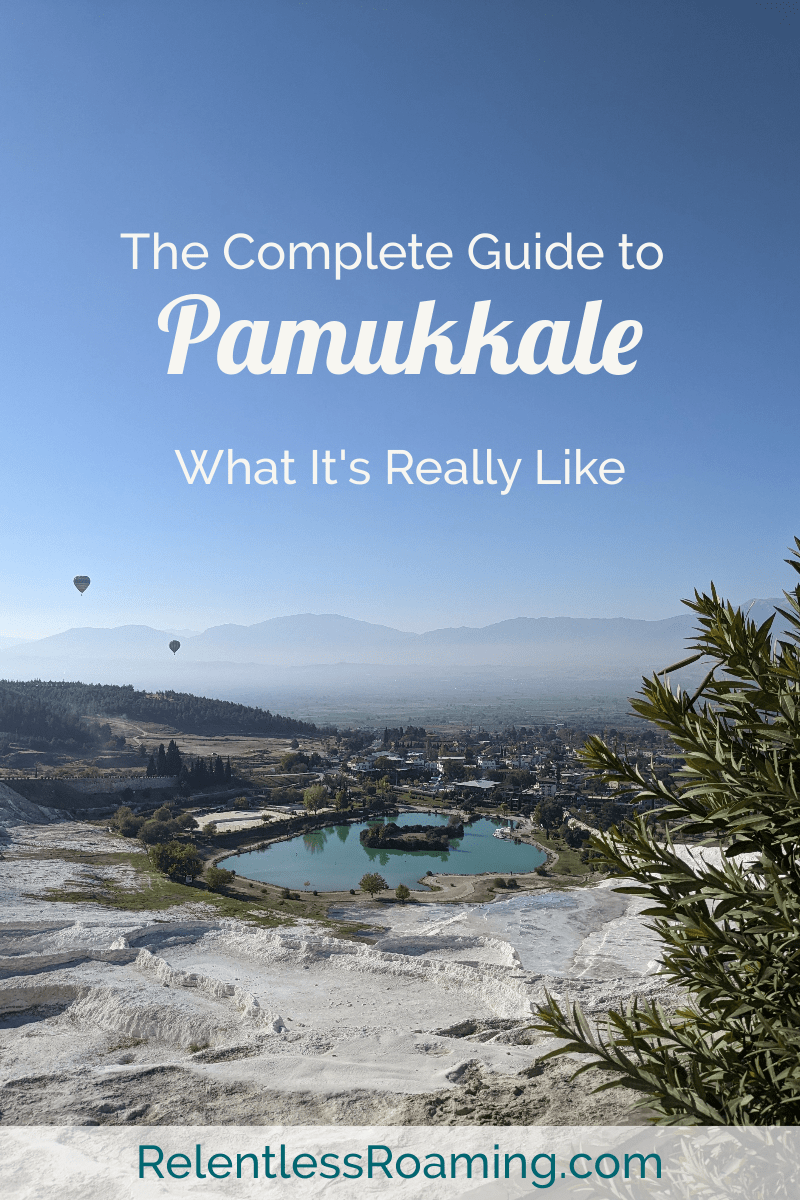Travel Guide to Pamukkale Hot Springs in Turkey
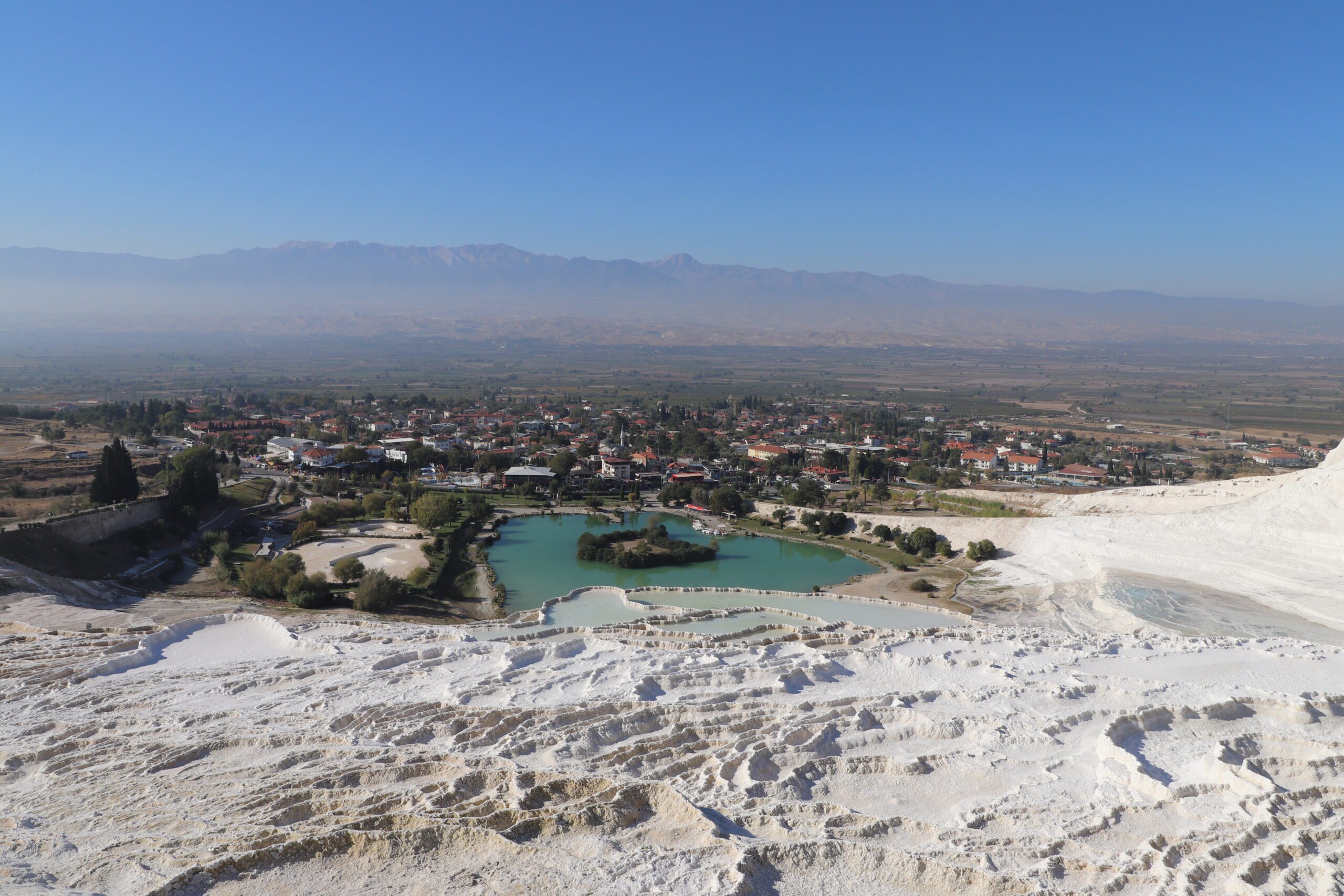
Pamukkale, literally meaning cotton castle in Turkish, is UNESCO World Heritage listed and one of Turkey’s most visited tourist attractions. The area is famous for its calcium carbonate rich waters from its thermal springs and the ruins of the ancient city of Hierapolis.
These waters have created an otherworldly landscape of travertine pools down a hillside that look velvety in texture. Grab yourself a tea, paddle your feet in the warm water and admire the phenomenal views. Find everything you might need to know to prepare for your trip in this complete Pamukkale guide.

The pools from the mineral waters are also famous in the social media world. You’ll find pictures everywhere of people posing for photos around the pools or bathing in them, and that made me sceptical as to whether this was a place for us.
Maybe it’ll be really busy. Maybe it’ll be really commercialised. Maybe it’s overhyped. Maybe the photos I’ve seen have been overly edited.
I had more or less talked myself out of planning it into our Turkey itinerary, but Chris wanted for us to give it a go. And this was the absolute right decision. We spent a really lovely day exploring the pools and Hierapolis ruins.
So, is it worth visiting Pamukkale? Yes.
And if you have any of these similar thoughts or just want a better insight into what a visit to Pamukkale is like, I have put together this guide. It brings together answers to all of the questions that my overthinking mind posed, as well as advice and tips I wish we had known before visiting.
Disclaimer: This blog post may contain affiliate links, which means that if you click and purchase through a link, we may earn a small commission at no extra cost to you. And if you do choose to do this, THANK YOU so much for supporting us! It means that we can continue to create content for you guys. Full disclaimer here.
Brief History of the Thermal Waters and Hierapolis
In 2nd century BC, the Greek settlement of Hierapolis became recognised as a thermal spa before being quickly turned to the hands of the Roman Empire. The ancient city was constructed next to the thermal mineral springs of what is now known as Pamukkale, as it was believed that the waters cured illness.
Hierapolis therefore became popular with the wealthy, who were sick or elderly, coming to visit or stay in this spa resort town. After a series of catastrophic earthquakes, Hierapolis was left largely abandoned by the 14th century, and was rediscovered in the 20th century.
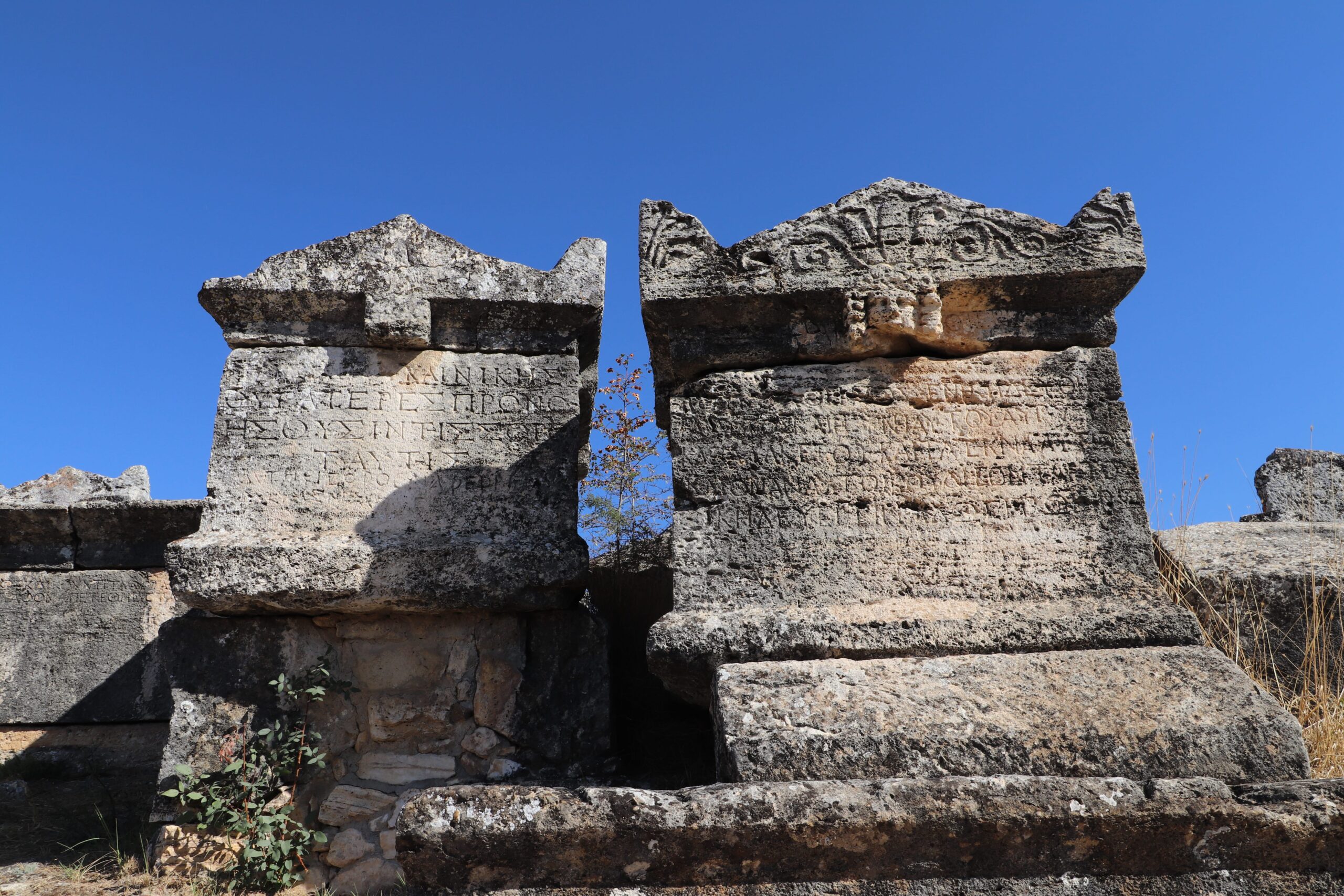
Pamukkale FAQ’s
Why does it look like this?
The thermal spring water is rich in calcium carbonate. When the water comes out from the spring, it travels down the hillside and deposits the mineral on to the ground. Over millennia, we have the resulting build up that you see today of white sedimentary rock called travertine.
Is it worth the hype?
Yes (pros)
But also, no (cons)
Where is Pamukkale?
Pamukkale is located in south west Turkey close to Denzili. Pamukkale is the name shared between the travertine pools as well as the town at the base of the pools where you will find, restaurants, shops and accommodation.
What time of year is best to visit?
You can visit Pamukkale all year round. Summer is the busiest time of year because of the hot weather and the general increase of tourists to Turkey overall. When visiting the pools and the ancient city, there is no cover and you are fully exposed to the sun. The heat can be unbearable, so I would avoid this time of year.
The shoulder seasons: May-June, September-October would be more pleasant times to visit. Fewer tourists and milder temperatures.
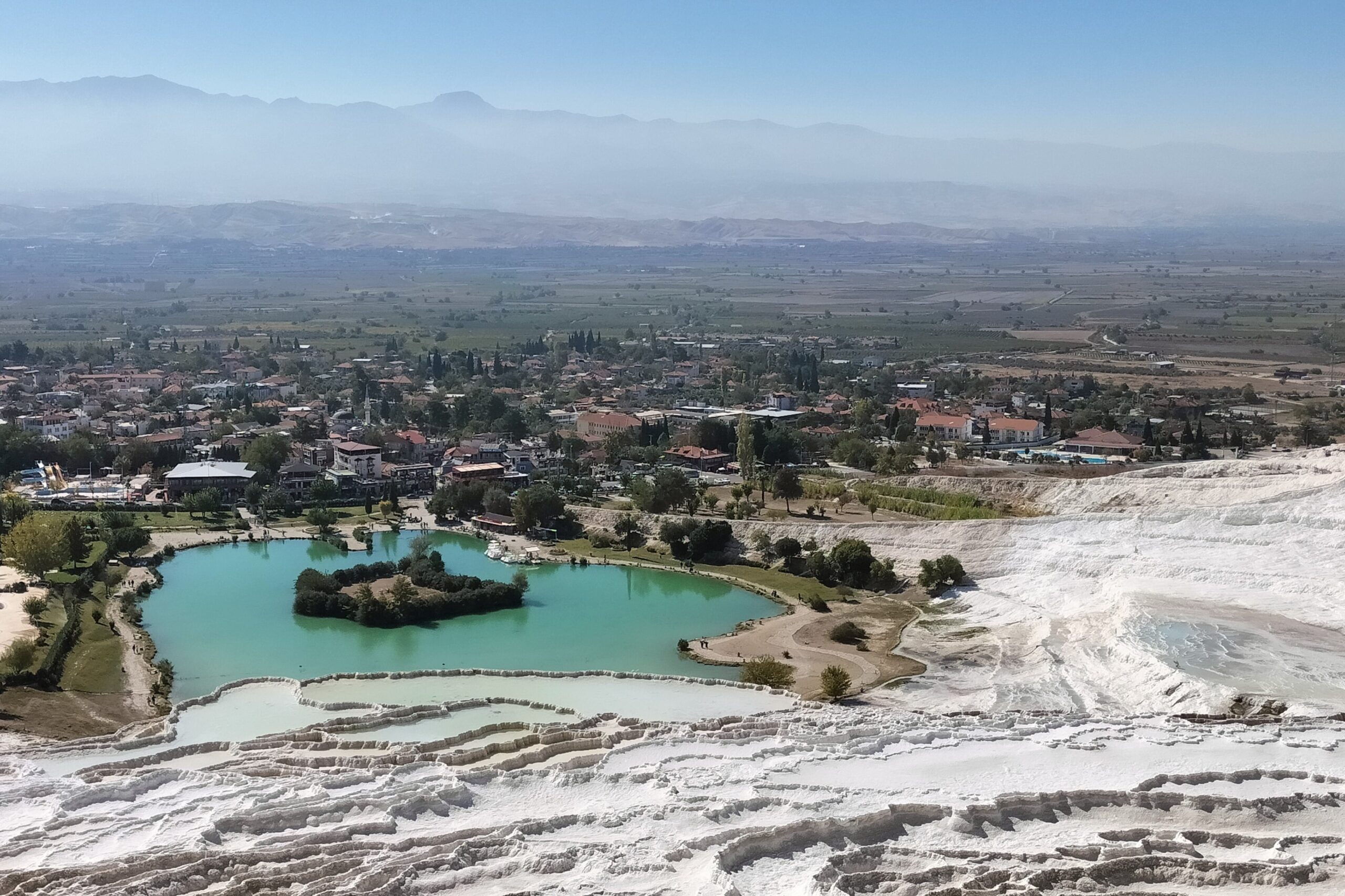
How do I get to Pamukkale?
You need to get yourself to Denizli. Here is the closest major train and bus stations to Pamukkale. There is also an airport in Denizli (DNZ) that is serviced only by Istanbul.
Denizli is a very well-connected city and you can get there by bus from most major cities around the country.
From Izmir, jump on the train to get you there in about five hours. There are at least five trains that take this route each day. We got the 07:10. Otherwise, there are buses from all over the country that service Denizli.
If you arrive into Denizli train station, leave the station and cross the main road to find the bus station.
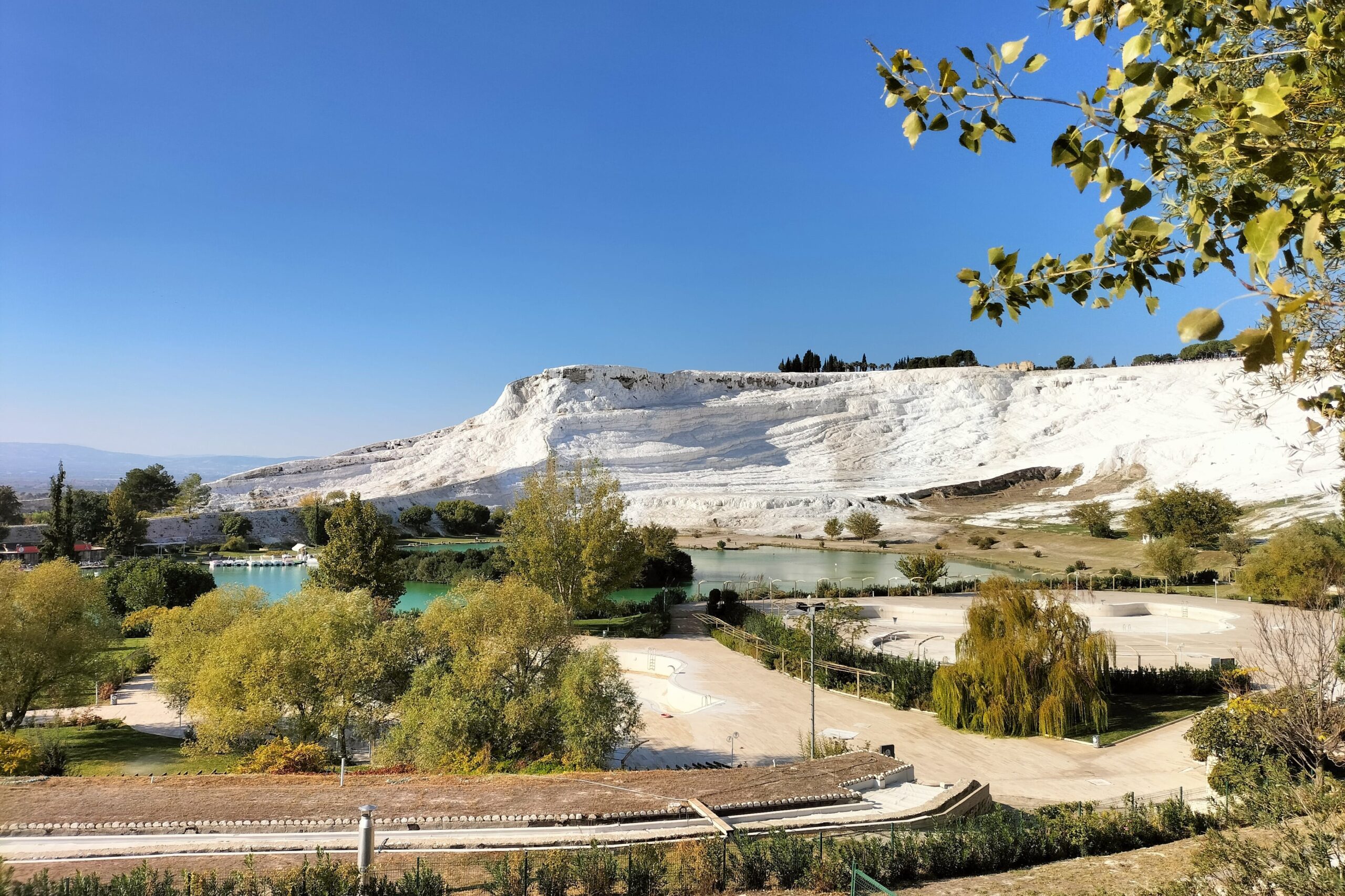
Enter the bus station (you may have to scan your luggage), and then head down the escalators one floor. Turn right and head out to the minibus park to peron (bay) 67 to catch the shuttle to Pamukkale. They supposedly leave every 20 minutes, so you shouldn’t be waiting long. Jump in the bus and pay the fee in cash when you get off the bus. The journey takes 20 minutes and you can get off the bus at a bus stop in the centre of town or at a stop near the Pamukkale pools entrance.
Be aware – a couple on the bus paid for their tickets when they got on the bus, and then were asked to pay again when they left. They had no proof that they had already paid at the bus station and so ended up having to pay twice. If you’re asked to pay up front, ask if you can pay at the end, or make sure that the driver knows that you have already paid.
To get back to Denizli, wait at that same bus stop where you were dropped off, and it’ll be the same procedure reversed.
Haven’t bought your travel insurance yet?
We have used SafetyWing for the last three years of backpacking, and we 100% recommend it, whether you are travelling for a couple of weeks, months, or years. And it is the most budget friendly, best value option out there!
Purchase your SafetyWing Travel Insurance.
How much is a Ticket?
The ticket cost us 200 TL in November 22, but as of 2024, the price has soared to about £25! This includes entrance to the pools and the whole of Hierapolis ancient city. It is a single entry ticket to be used on the date of issue. Therefore you cannot buy it in advance, or leave and re-enter.
There are audio guides available for an additional fee, but I have only heard bad reviews about them.
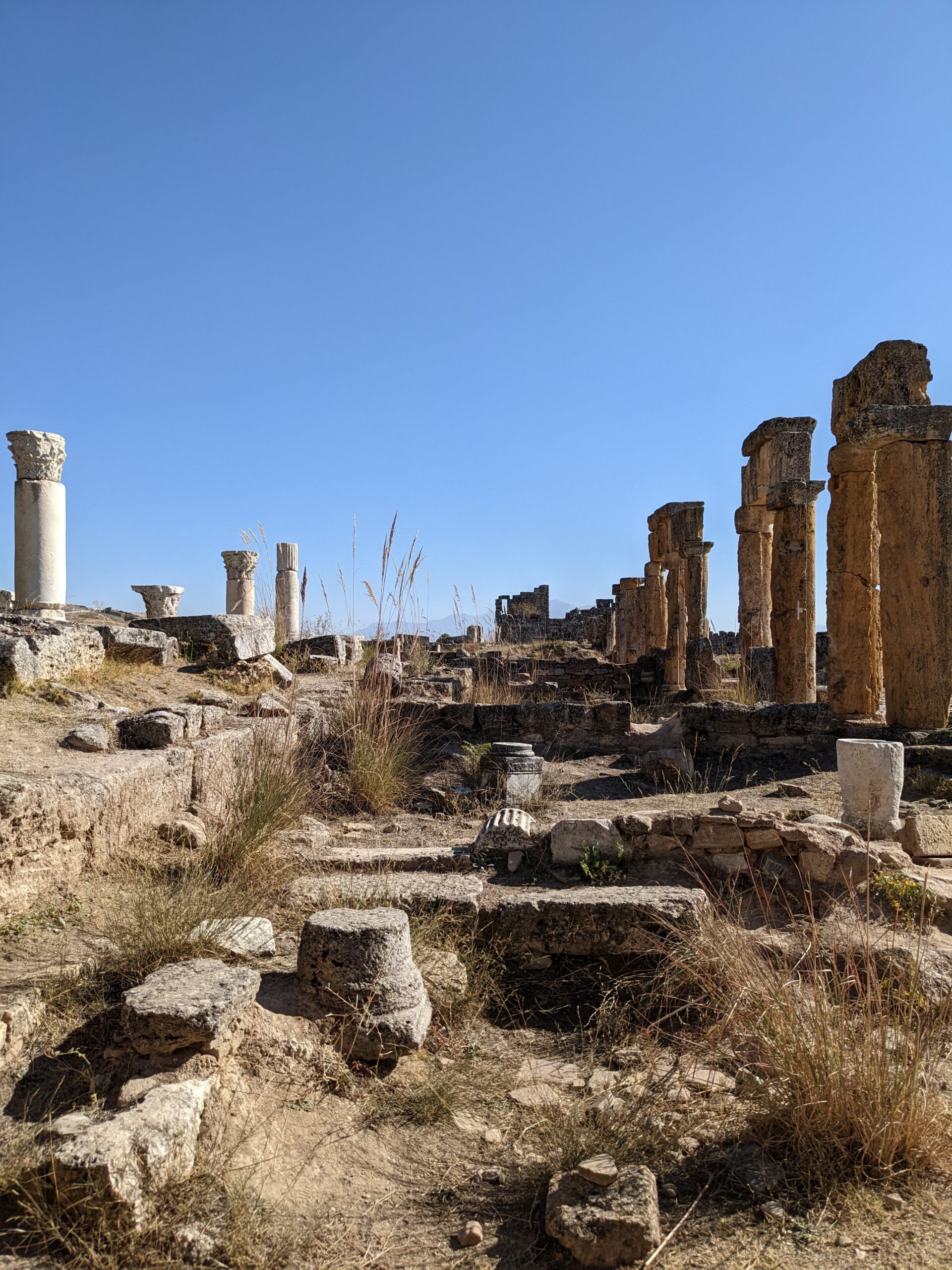
Can I visit as a day trip?
Yes, you can. There are organised tours that will take you there and back in a day from Istanbul, Izmir etc., but it will be rushed and you won’t be able to see everything. If you are short on time anyway, this makes sense, but if you have a couple of days, stay in Pamukkale town for a night or two.
How long should I spend in Pamukkale?
Between exploring the travertine pools, stopping for lunch, and exploring the ancient ruins of Hierapolis, you could easily spend the whole day (which is what we did).
You could maybe spend an hour walking slowly through the pools, taking in the views and taking all your photos. The ruins, however, are particularly spread out. Just walking from one end of the site to the other could take a good hour. So really, it depends on your interest in ancient ruins. A visit to Pamukkale could be a couple of hours or a whole day.
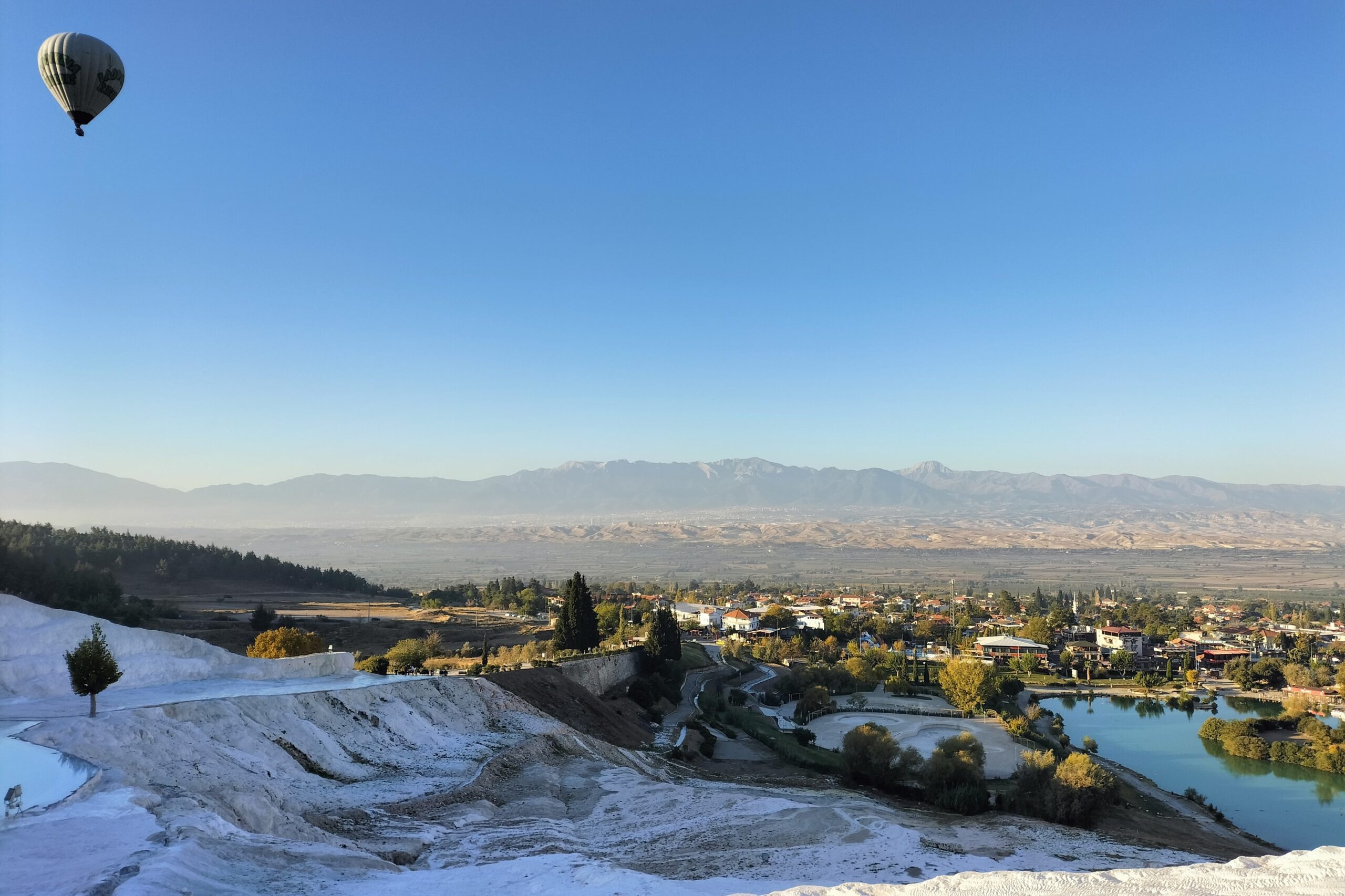
What should I wear?
I would recommend not wearing long trousers, skirts etc. because you’ll spend the whole time hitching them up so they don’t get wet.
Wear swimmers if you want to bathe. Wear shoes that are comfortable for walking around the ancient ruins, but also be prepared to remove your shoes for walking on the travertine. You are only allowed to walk in and around the pools barefoot.
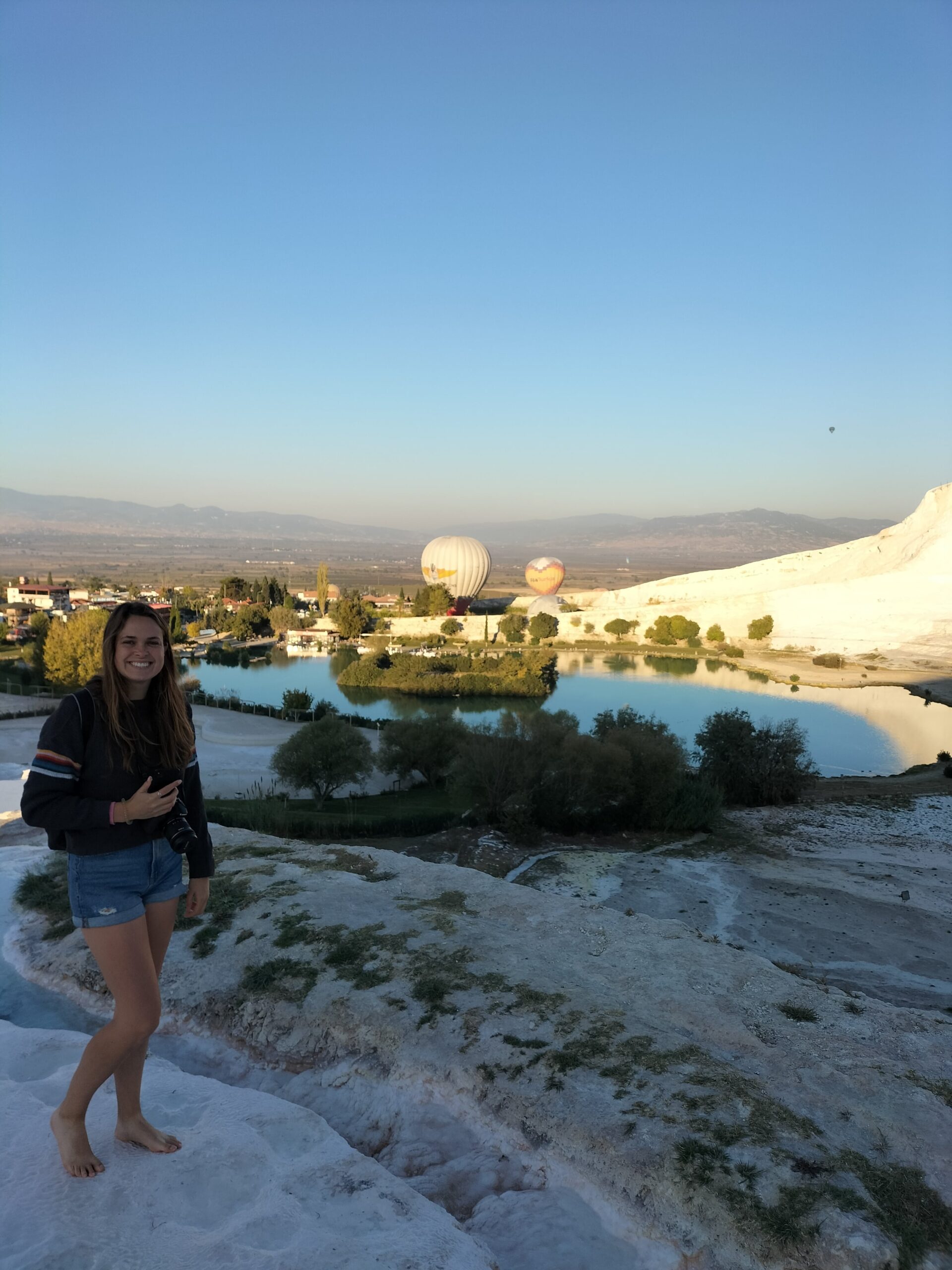
Accommodation recommendations?
We would thoroughly recommend Sunrise Aya Hotel. Close to where the shuttle bus will drop you, the entrance gate and restaurants, it has the perfect location. The rooms are small with all the basics you would need. There is a pool filled with the natural water from the thermal springs and a large garden area with a small wooden hut bar. It’s a family-run business and they are such lovely people.
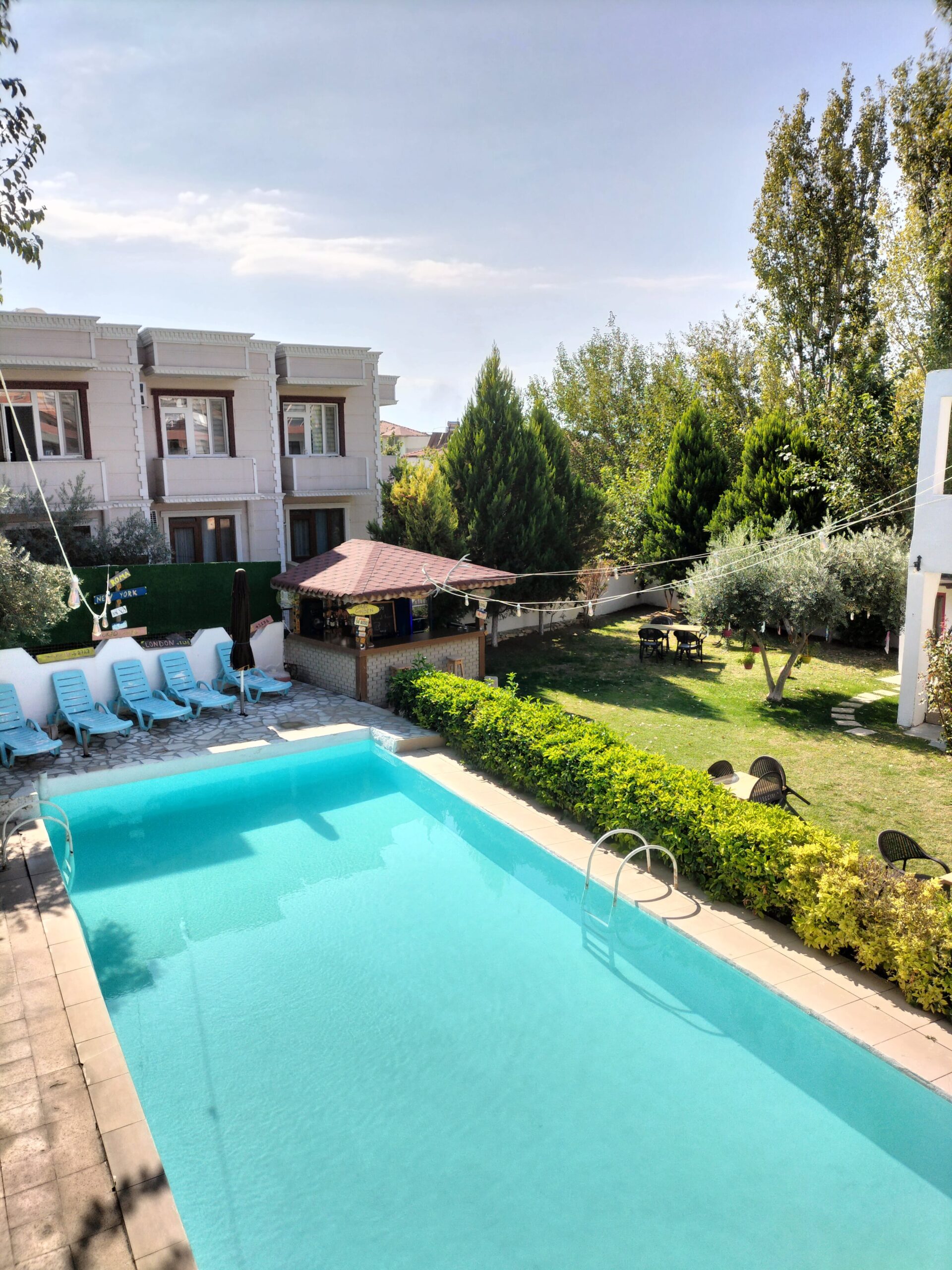
Is it dangerous and slippery?
Some parts are slippery, so definitely watch your step. But I would say that the majority of the travertine feels like you are walking on a moderately spiky pomace stone so offers a considerable amount of grip. You have to walk barefoot across the pools. But no, I would not say it is dangerous. Just like with anything, be careful.
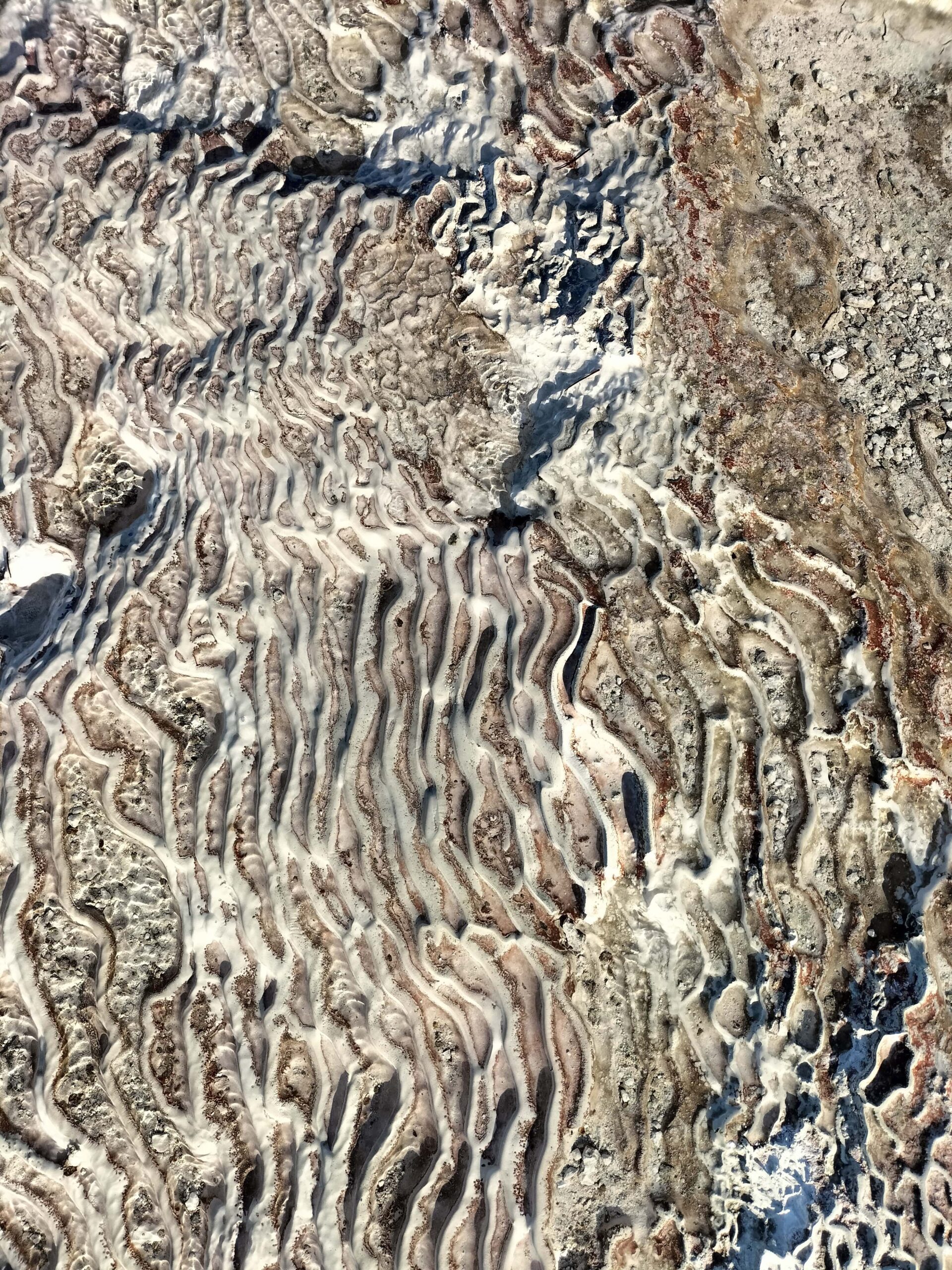
Is it commercialised?
Yes. The restaurant on site sells a cup of tea for 18 TL (when everywhere else in Turkey was selling it for 5 TL). When we were there, men were wandering up and down the pool trying to sell huge pairs of colourful feathered wings for people to wear to take their ‘perfect’ photo.
However, you can avoid this like we did, and I promise it is worth visiting regardless of all this! I was super sceptical about it all before we went, but I really enjoyed our day exploring the pools and the ancient ruins. Arrive early before all of this madness starts and bring a packed lunch.
Savvy Traveller Pro Tips 🇹🇷
After exploring Turkey for six weeks, these are our favourite booking tools that we couldn’t travel without!
When is the best time to go to avoid the crowds?
Get there first thing for when the gates open. Most people visiting Pamukkale do it on an organised day trip, so they won’t be there for a couple of hours. Once it hits 10:00 the day trippers will be in full swing and it all gets a bit much. But head over to a different area of the travertines and the ancient ruins and you can avoid the crowds.
Any tips to visit Pamukkale?
Get to the Town Entrance as soon as it opens and walk up the travertine. Most people visit on a day trip, so you’ll likely have a couple of hours before the day trippers descend.
Take your photos, maybe treat yourself to an expensive tea at the top by the thermal springs and dangle your feet in the warm water while looking out over the view. As this area starts to get into full swing with crowds, leave and follow the path across the top of the travertine to the right of the restaurant. People don’t seem to venture this way, so it’ll be lovely and quiet and you’ll still have the stunning views of the snow white travertine contrasting with the rest of the lush and green landscape.
From here, head upwards to the ruins of the ancient city of Hierapolis. Again, not many visitors actually explore the ruins so it’ll be relatively quiet. Unfortunately, there are no maps and there is very little information, just a few signs to point you to the main sights.
We explored the ancient ruins, had a picnic lunch and headed back to the quiet area overlooking the pools to wait for sunset. Because we were here in November, the sunset was quite early around 18:00.
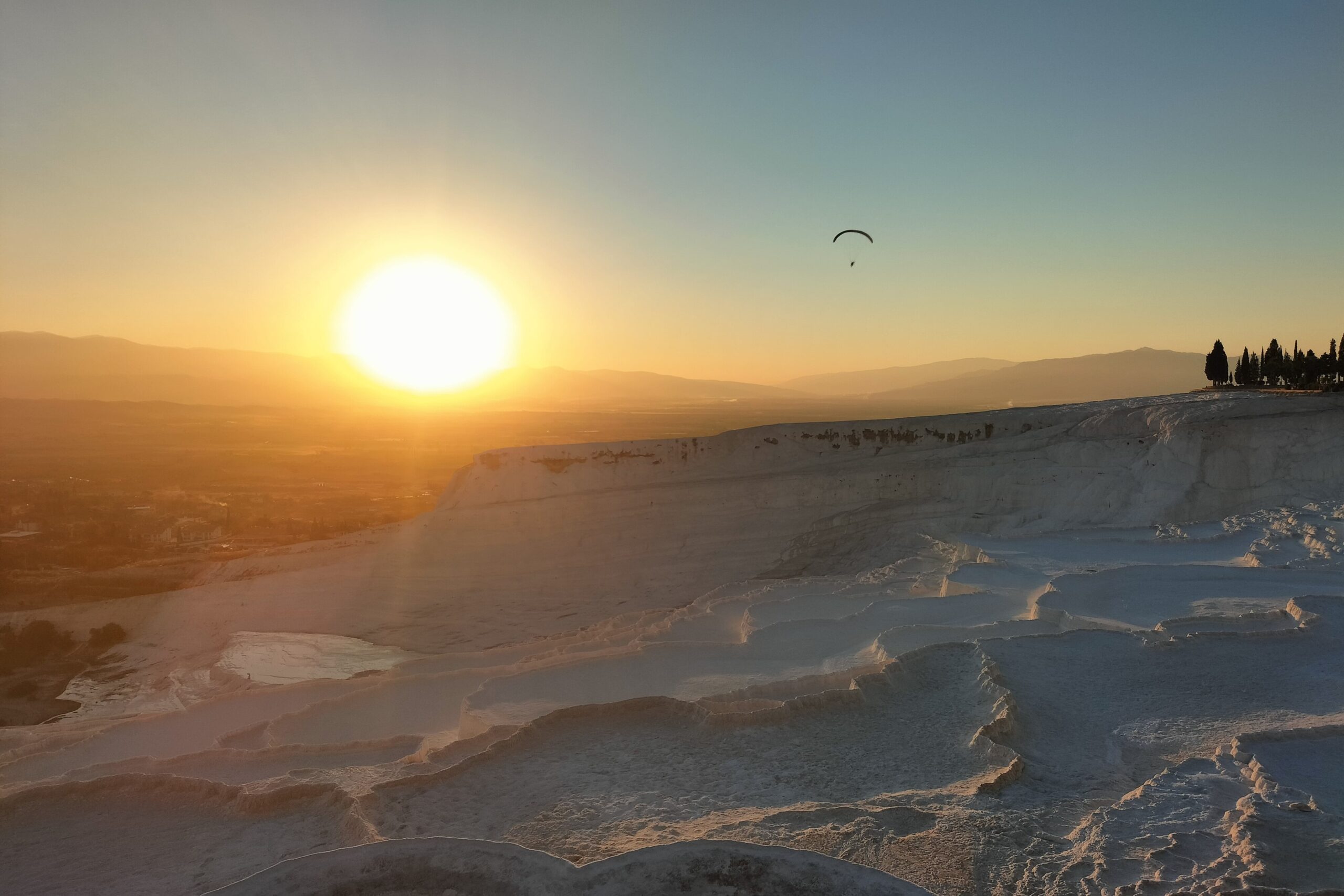
Is Hierapolis (ancient city) worth visiting?
Yes, start at the Grand Theatre. It is huge, hence the name, and is high up in the mountainside, meaning that it offers sweeping views over the rest of the landscape. Wander down the steps to see the intricate detailing of the columns and statues of the stage.
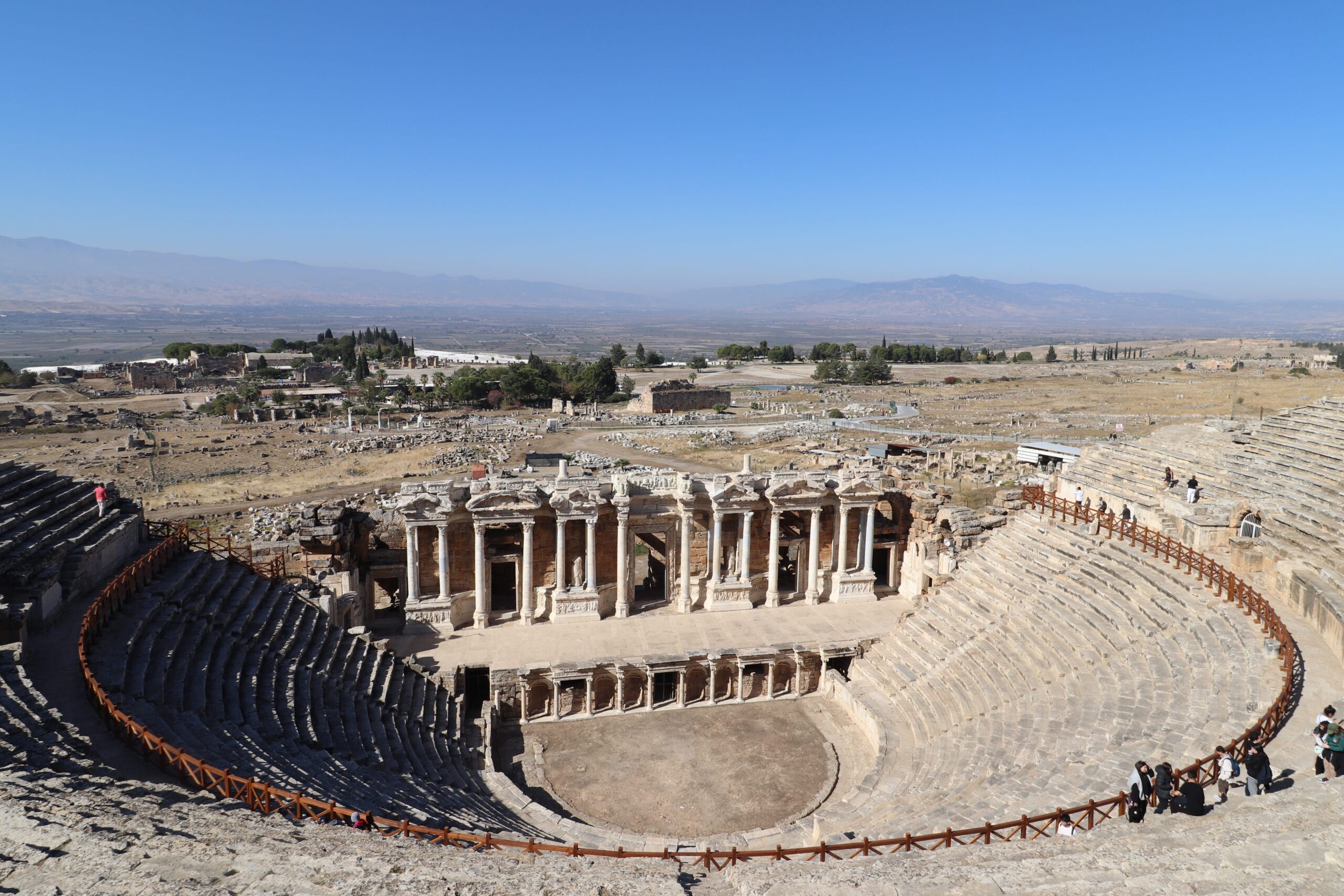
Explore St. Philip’s Martyrium and the Old Theatre, before walking the full length of the necropolis. The ruins of the necropolis were outstanding. There were a few plaques with information on different building techniques of structures. Spot the detailed decoration chiselled into the stone.

Then venture back into the centre via the colonnaded street and explore the ruins either side of this street. Wander through the triple arched entrance, walk the Greco-Roman road and see the enormous columns. Veer off periodically to see smaller ruins.
All in all, we probably spent about three hours exploring the ruins. There is a lot to see and the sights are pretty spread out.
What time does Pamukkale open?
So, there doesn’t seem to be any solid information online about the opening times of the gates. Some state 24 hours, which is incorrect. The best way to do it, is to check with a local before you go.
The other layer of complexity is that there are three entrances: Town Entrance, South Gate and North Gate, and each one has its own opening times that change with the seasons. Madness.
We visited via the town entrance, and if you’re staying in Pamukkale town, I’d recommend you do the same. We were there in November and it opened at 08:00. Our accommodation host informed us of the below opening times:
The Town Entrance allows you to enter from the base of the travertine pools and walk your way up to the top. You have to remove your shoes walking through the pools. This is the entrance I would recommend you use if you are staying in Pamukkale and do not have your own transportation.
The South Gate brings you to the top of the pools. This is where a lot of the tour buses arrive. I would recommend this entrance if you have transportation as there is plenty of space for parking.
The North Gate brings you in at the end of the necropolis of Hierapolis. This will take you a good 30/40 minutes to walk to the pools. I just wouldn’t recommend this one as it’s too far out the way.
Are there facilities on site?
Yes. There are toilets at both ends of the site – in the necropolis and at the quieter end of the travertines: at the end of the boardwalk to the right of the restaurant at the top of the pools.
There are two restaurants on site but they are really expensive. A tea here cost us 18 TL when it costs 5 TL everywhere else in Turkey. We made ourselves a wee picnic of shop-bought cig kofte, simit from a local bakery, bananas and water. I would thoroughly recommend bringing lunch with you if you are planning to stay for the whole day.
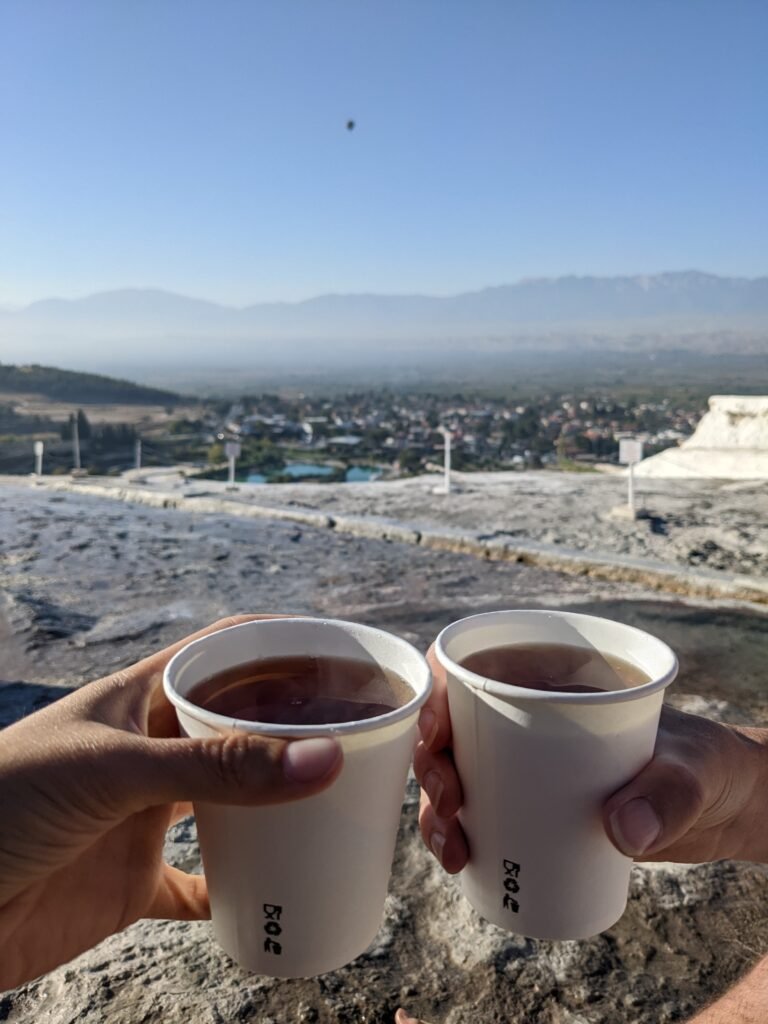
What should I bring for a day at Pamukkale and Hierapolis?
In a Nutshell
Spending a day exploring the otherworldly travertine pool landscape and the ruins of Hierapolis is well worthwhile. Just prepare yourself for the crowds and the commercialised elements beforehand and veer away from this part when the huge day tripper crowds descend.
Plan more of your trip with these:
- Travel Tips for Turkey: 10 Actually Useful Things to Know
- Things to Do in Turkey: 12 Best Spots for Your Itinerary
- Transport in Turkey: 18 Top Tips for Getting Around by Bus
- Turkish Vegetarian Food: 20 Dishes You Have to Try
- The Ultimate Guide to the Full Turkish Breakfast (plus the best places to eat!)
- How to Drink Turkish Coffee & Decipher the Coffee Menu!
- 8 Tasty Turkish Drinks You Need to Try
- 23 Unique Things to Do in Istanbul
- 9 Fascinating Things to Do in Goreme Cappadocia
- Complete Derinkuyu Travel Guide: The Lost Underground City
- 7 Things to Do in Gaziantep: the City of Perfect Pistachios
- 8 Captivating Things to Do in Sanliurfa
- How to Visit Göbekli Tepe
- 6 Best Things to Do in Mardin, Turkey
Like it? Save it!
